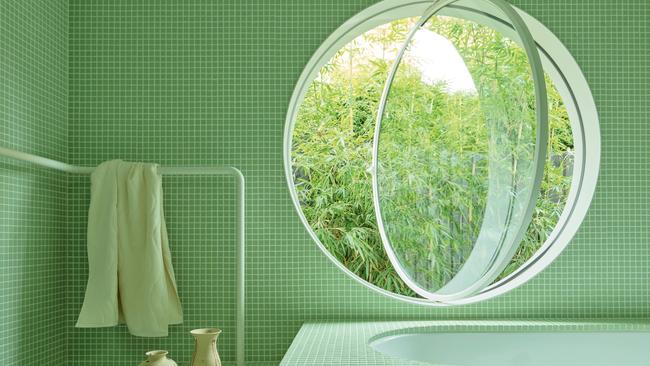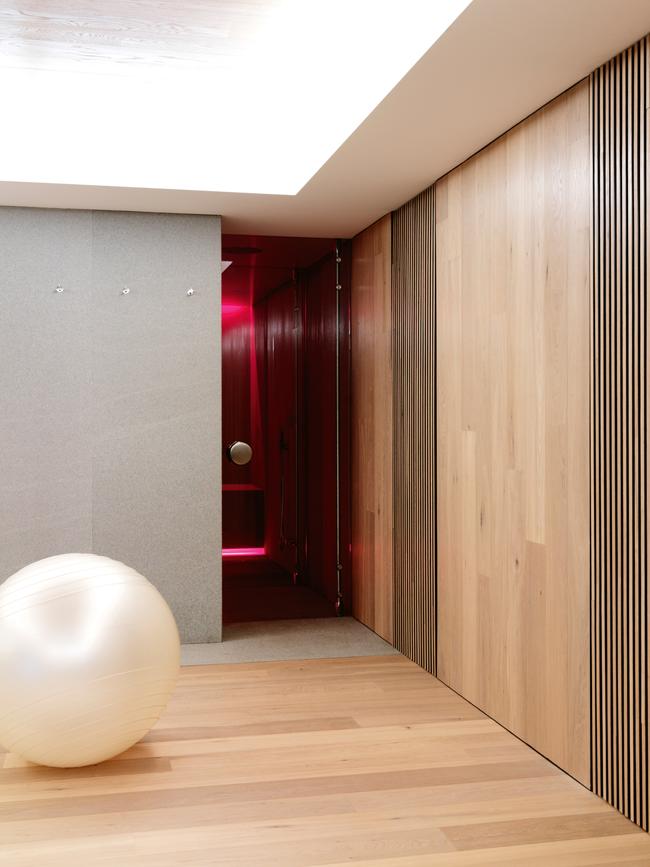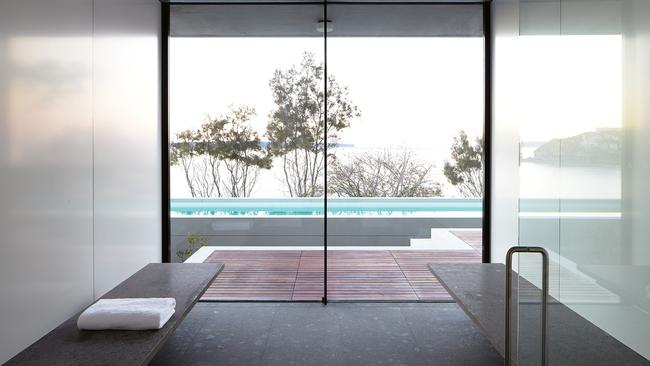Health havens the top home improvement trend
In the 80s and 90s, these rooms were in the garage or by the pool. Now architects are being called on to create these bespoke spaces proudly front and centre in luxury homes.

Well-heeled homeowners have taken interiors inspiration from international travel and luxury destinations for decades. But the desire to replicate the blissful serenity of an exclusive hotel or spa retreat is now being taken to new levels of opulence in private homes. Integrated bespoke wellness spaces have become the latest must-have in houses that boast the best of everything. And it’s not about capitulating to the latest trend; there’s authenticity in the intention and the design process. Australia’s top architects are being called on to create sumptuous sanctuaries featuring beautiful bathing spaces, soothing timber saunas, earthy steam rooms, state-of-the-art home gyms, mediation, yoga and Pilates studios and private massage rooms for a range of clients who are prioritising their physical and mental health.
Historically these once unsightly home wellness offerings were banished to basements or out near the pool, but many are now proudly front and centre in prime locations within the home, as architects and interior designers work together to create personal health retreats. Tobias Partners founding principal Nick Tobias says almost every house he designs now has a steam room or a sauna as the starting point to a more significant fitness and wellbeing space. “There’s a bespoke attention to detail for the design of it, not feeling like they’re proprietary, but like they’re integrated into the overall detailing of the architecture of the house. It’s now on the list of things for affluent people: ‘I’ve got the great house. I’ve got good furniture. How am I going to live well there for a long time?’,” he says. “Back in the ’80s and ’90s, a sauna was with the pool equipment or in the garage and there was nothing around it. Now when you step out of a sauna, what is the experience you want to have? Being able to get chilled, fresh water, to take a nice cold shower, have a beautiful spot for your towels, a bench to sit on. All those things make it feel a bit like your own wellness club.


“The sauna becomes part of a more designated precinct that’s focused on wellness and often exercise, whether it’s a room that’s great for stretching, yoga, Pilates, weights. All those things tend to often go hand-in-hand. I think these luxury houses in general have over the years become more like mini hotels. It goes back to people wanting to bring their holiday life back to the everyday life.” Among the questions clients ask is which style of sauna is best. But Tobias says it comes down to personal choice. “There’s constant debate between the traditional Finnish sauna versus the infrared sauna. Ultimately the research I have read is the health benefit is very similar between the two. It’s just a different process that leads to the same outcome,” he says. “I like the social aspect of a [traditional Finnish] sauna, having mates over, sitting in the sauna and having a yarn. It feels to me like the whole act of putting water on the coals and putting essential oils in, gives a greater sense of ritual. And ultimately, it feels more sociable for a group of you to sit around hot rocks having a conversation rather than sitting in something that feels a bit more akin to a microwave.”
While saunas and steam rooms have long been popular, an increasing number of clients are integrating cold therapy into their daily routines. “Cold therapy has become a big one. It’s not everyone’s cup of tea. It’s harder to commit to than heat. You’ve seen cold therapy go from people putting bags of ice in their bathtub to now having integrated, chilled and filtered water going into a bath, pool or spa. It’s an architecturally integrated approach to cold therapy,” Tobias says.

Kennedy Nolan founding partner Patrick Kennedy says the pandemic played a significant role in elevating the demand for wellness oases in private homes. “People were spending more time at home and that made them reappraise what they did. Whereas prior to that, where you live was more of a place to sleep and eat, [but] because we were all locked up, people started to think, ‘Oh actually, what can I do here?’. And that has definitely translated into wellness,” Kennedy says.
Luxury apartment buildings have been home to opulent pools and spas for decades, but the recently completed Saint Moritz development in Melbourne’s St Kilda is the first to include wellness amenities of a standard previously seen only in six-star hotels.
Saint Moritiz, rumoured to be home to a host of rich listers, sporting stars and bold-faced names, has a first-of-its-kind private anti-ageing and wellness clinic for residents. It is touted as the most ambitious health and wellness facility ever offered on a private scale in Australia and features include a $150,000 state-of-the-art cryotherapy chamber, hydrotherapy showers and salt therapy. The Melbourne Builder & Co.’s Dale Cheesman says he is seeing a distinct rise in interest in home wellness spaces for his high-profile clients post covid, with some willing and able to spend more than $250,000 on a dedicated wellness space.
“I think what’s come out of covid is that it showed that your immune system is really important and that you’ve got to keep your immunity up to fight viruses that we get exposed to every day. We’re doing a $4 million renovation in Toorak at the moment, and they’ve dedicated serious space for a wellness centre, hot pool, cold pool, sauna and a massage room,” Cheesman says. Quality bespoke equipment is also high on the shopping list for wealthy clients fitting out their homes for fitness with functionality as well as aesthetics.

Debra Tay, co-founder of Cycling Bears, Australia’s first bespoke fitness equipment provider, says clients are more discerning when it comes to materials, choosing luxurious natural materials over synthetic. Among Cycling Bears’ fully customisable equipment range is a leather and steel fitness set for $17,000, and a $32,545 glass exercise bike, which looks more like a piece of art. “We have also seen more clients wanting a wellness space that blends seamlessly with the rest of the home, that is beautiful and attracts them to want to enter, so that exercising is a treat and positive experience rather than a chore,” she says. Award-winning luxury architect Rob Mills says covid simply accelerated a trend that he’s seen emerge in earnest in the past decade. “People were trapped in their homes and there’s a risk of that happening again. I think they’re equipping themselves for the environment that really is a pleasure to live in. Covid brought everyone’s attention to living healthily, more so than in the past,” he says. “For years now we have been producing buildings that are healthy to live in, no toxins, no VOCs [volatile organic compounds]. [Not using materials] like a polyurethane floor coating over timber that’s applied two weeks before you move in and then you live with the product and inhale toxins for the first few months. Adhesives and lots of paints also have VOCs in them. We’ve eliminated those to create something that’s physically healthy to live in.”
Air and water quality in the home are also now major considerations for luxury homeowners. “Filtration really started to take off after the bushfires. It has become a big one where people are concerned about the quality of the air that they’re breathing. The other thing is we’re doing more houses where you’ve got a whole-house water filtration system. They’re both things that have become conversations we’re having with clients now and relates back to wellness,” Tobias says.
Wellness real estate has become big business, rising to $US398 billion globally in 2022, up 177 per cent from 2019, according to non-profit Global Wellness Institute. A projected annual growth rate of 17.4 per cent between 2022 and 2027 is expected to increase the global market to $US887.5 billion. “The pandemic radically accelerated the growing understanding among consumers and the building industry about the critical role that external environments play in our physical and mental health and wellbeing,” the Global Wellness Institute’s 2023 Global Wellness Economy Monitor Report states.

Kennedy says an increased awareness of sustainability is also feeding the new-found focus on health and healing. “There’s a synchronicity with sustainability. There are a lot of interesting natural materials that are local and don’t have carbon miles on them. There’s a synchronicity … because now we have new regulations, which are requiring you to have six- and seven-star energy ratings. To achieve those, they will actually look and behave in a certain way which parallel with wellness,” he says. Mills, meanwhile, is currently constructing an eco lodge in the Howqua Valley in Victoria that will be used as a family retreat. “This place is designed to be a sanctuary that’s got a heated pool, sauna, ice bath, separate living spaces, and the ability to day-bed in each of the bedrooms so you can retreat to the bedroom and get some peace and quiet,” he says. “It’s made of natural and recycled materials, and it’s completely powered by the sun. Water comes from the earth and from the sky, rainwater is harvested. The septic is treated in a worm farm as opposed to a conventional storage plant. We’re recycling all the way down to the furniture. “Why is that important? It’s all related to wellness. I think if we can conserve energy creating these buildings and reuse things, it requires less energy to make them work. It’s embracing a way of life.”
Kennedy, too, is seeing clients wanting more visual and physical comfort, rather than just a trophy home. “The current tendency in interior design is to make places where people want to spend time rather than making spaces which are about showing off or exhibiting a taste. It’s more about making places that suit you as an individual or a family,” says the architect. Tobias says we’re on the cusp of integrating even more innovative wellness technology into private residences. “This is getting bigger and bigger. There’s a lot of proprietary stuff out there that will be really fun to integrate. Red light therapy is a good one. Some will stimulate collagen, some stimulate melatonin. It can stimulate different reactions in the body, different brain chemistry, and different things in the skin. I haven’t been given a brief yet to integrate one but I’m looking forward to it.”
This story appears in the February issue of WISH Magazine, on sale Friday February 2 inside The Australian.

To join the conversation, please log in. Don't have an account? Register
Join the conversation, you are commenting as Logout